Regulations for Acceptance Tests of Aircraft Engines
Provided by Michał "Hiromachi" Czubak
via The Air Force Historical Research Agency
CINCPAC-CINCPOA SPECIAL TRANSLATION
Item#9777
Subject: Regulations for Acceptance Tests of Aircraft Engines.
Administrative Equipment Order (NAIREI HEI) No. 83 (1942), Annexed Volume.
Source: Captured on Saipan, July 1944 |
| Administrative Equipment Order (NAIREI HEI) No. 83, (1942), Annexed Volume |
| History |
| Effective Date (Revision) | Adm Equipment Order No. |
| January 1927 | Adm Equip Order No. 11 |
| June 1933 | Adm Equip Order No. 35 |
| August 1934 (Supplement) | Adm Equip Order No. 30 |
| May 1938 | Adm Equip Order No. 22 |
| January 1939 (Supplement) | Adm Equip Order No. 6 |
| October 1942 | Adm Equip Order No. 83 |
Contents
Chapter I - Introduction
Chapter II - General Rules
Chapter III - Structural Tests
Chapter IV - Operational Tests
Chapter I - Introduction
Item 1 - The following specify the regulations which concern aircraft engine acceptance tests.
Item 2 - The purpose of aircraft engine acceptance tests is to assess the practical value of the engine's construction, performance, reliability and endurance.
Item 3 - The OinC (Naval Air Headquarters) will specify separate regulations, based on the present ones, for the acceptance tests of special type engines which are not adequately covered by these regulations.
Item 4 - Besides these regulations, separate regulations for aircraft engine construction and repair tests should be used wherever applicable.
Item 5 - Details of test procedure will follow procedures established separately by OinC.
Item 6 - When tests are to be carried out according to these regulations, the OinC will notify the departments concerned.
Item 7 - Acceptance tests conducted under these regulations will be made on the following engines:
- 1) Experimental engines.
- 2) Engines which are judged to need acceptance tests after modifications.
- 3) Others which are judged to need acceptance tests.
Item 8 - Acceptance tests will be subdivided as follows:
- 1) Structural tests.
- 2) Operational tests.
Item 9 - The entire acceptance test procedure is to be followed for experimental engines.
Item 10 - Entire or partial test procedure is to be followed for remodeled service type engines as indicated by the OinC.
Item 11 - Acceptance tests will be conducted at the Air Technical Depot as a general practice. Where deemed necessary, part of the acceptance tests may be conducted at the factory.
Item 12 - All factory tests and inspections will be conducted in the presence of a supervising or inspecting official.
Item 13 - Instruments, machines, equipment, and units of measurement used during tests and inspections must be approved by the OinC.
Item 14 - Tests of experimental engines will be conducted on engines for which tests have been completed at the factory. These tests will follow the procedure for tests of engine performance and second operational tests on the same model engine as determined by these regulations.
Item 15 - When the manufacturer desires acceptance tests to be made on an experimental engine, he will submit two copies of the following data along with the application to the OinC, Naval Air Headquarters and forward these copies to the OinC, Air Technical Depot.
- 1. Longitudinal and transverse cross sections, assembly diagram, charts of clearances, and installation diagram of the engine.
- 2. Front, rear and side view photographs.
- 3. Provisional operating instructions and provisional installation outlines.
- 4. Essential engine specifications.
Chapter II - General Rules
Item 18 - The rated output of an aircraft engine is the output at rated altitude and rated horsepower (HP). For engines with variable speed superchargers, the rated output at first rated altitude and at rated HP. This applies also to engines equipped with continuous variable pressure (speed) superchargers.
Item 19 - When the rated output of an engine is 300 HP or less, multiples of 5 HP will be used, and when greater than 300 HP, multiples of 10 HP will be used to indicate output.
Item 20 - To indicate various manifold pressures, multiples of 5 millimeters will be used.
Item 21 - To indicate various revolutions per minute (RPM), multiples of 20 or 50 RPM will be used.
Item 22 - To indicate rated altitude, multiples of 200 or 500 meters will be used.
Item 23 - Terms used in the regulations are defined as follows:
- 1. Manifold pressure - The difference between absolute cylinder intake air pressure and standard atmospheric pressure (measured in mm of mercury).
- 2. Rated Manifold Pressure - The maximum pressure permissible for a period of not more than 30 minutes continuous operation.
- 3. Take-off manifold pressure - Maximum manifold pressure permissible for not more than one minute continuous operation during take-off. In emergencies, three minutes continuous operation is permissible.
- 4. Normal maximum manifold pressure - Maximum manifold pressure permissible for continuous operation over several hours. (Translators Note: This document makes far greater distinctions between Normal and Cruising ratings than any previous document.)
- 5. Engine RPM - Crankshaft revolutions per minute.
- 6. Rated RPM - Maximum RPM permissible for not more than 30 minutes continuous operation.
- 7. Take-off RPM - Maximum RPM permissible for not more than one minute continuous operation during take-of. In emergencies, three minutes operation is permissible.
- 8. Normal maximum RPM - Maximum RPM permissible for continuous operation over several hours.
- 9. High speed RPM - Max RPM permissible for glide or dive operations.
- 10. Idling RPM - Minimum practical RPM.
- 11. Altitude - Height measured in meters under standard atmospheric conditions.
- 12. Rated altitude - Max altitude at which rated manifold pressure can be maintained at rated RPM.
- 13. Horsepower - One horsepower equals work done at rate of 75 kilogram meters per second.
- 14. Rated HP at sea level - Shaft HP developed at rated manifold pressure, rated RPM, under standard (sea level) atmospheric conditions.
- 15. Take-off HP - Shaft HP developed at take-off manifold pressure and take-off RPM under standard (sea level) atmospheric conditions.
- 16. Normal maximum HP at sea level - Shaft HP developed at normal maximum manifold pressure and normal maximum RPM under standard atmospheric conditions.
- 17. Rated HP at rated altitude - Shaft HP developed at rated manifold pressure and rated RPM at rated altitude.
- 18. Variable pressure (speed) supercharger - Superchargers which can be consecutively changed over to several different pressure ratio levels. They are called two pressure (speed) and three pressure (speed) superchargers, etc., according to the number of different pressure ratios to which they can be changed.
- 19. Continuous variable pressure (speed) supercharger - Superchargers which, within a given range, can change to desired pressure values. These terms are applied with reference to the two pressure (speed) supercharger, which develops both extremes of pressure.
- 20. 1st (2nd, 3rd, etc.) pressure (speed) - Indicates increasing order of accelerating gear ratio of the variable pressure (speed) supercharger. Called 1st, 2nd, 3rd, … nth pressure (speed), etc., starting from the lowest pressure (speed).
- 21. Off supercharger - Time when the supercharger is not in use, in those supercharger-equipped engines which have transmissions which permit the supercharger to be completely disengaged.
- 22. 1st (2nd, 3rd, etc.) rated manifold pressure - The rated manifold pressure maintained at 1st (2nd, 3rd, ...nth) pressure (speed) respectively.
- 23. 1st (2nd, 3rd, etc.) rated altitude - Maximum altitude at which 1st (2nd, 3rd, ..nth) rated manifold pressure can be maintained with rated RPM with 1st (2nd, 3rd, ..nth) pressure (speed).
- 24. Rated HP at 1st (2nd, 3rd, etc.) rated altitude - Shaft HP developed with rated RPM and 1st (2nd, 3rd, ..nth) rated manifold pressure at 1st (2nd, 3rd, ..nth) rated altitude with 1st (2nd, 3rd, ..nth) pressure (speed).
- 25. 1st (2nd, 3rd, etc.) rated HP at sea level - Shaft HP developed with rated RPM and 1st (2nd, 3rd, ..nth) rated manifold pressure at standard (sea level) atmospheric conditions at 1st (2nd, 3rd, ..nth) pressure (speed).
- 26. Rated operation - Operation at rated manifold pressure and rated RPM.
- 27. Rated HP operation - Operation at sea level rated HP and rated RPM.
- 28. Take-off operation - Operation at take-off manifold pressure and take-off RPM.
- 29. Take-off HP operation - Operation at take-off HP and take-off RPM.
- 30. Normal operation - Operation at normal maximum manifold pressure and normal maximum RPM.
- 31. Normal HP operation - Operation at sea level normal maximum HP and normal maximum RPM.
- 32. Cruising operation - Operation at economical fuel consumption rates at various power outputs.
- 33. High speed operation - Operation at high speed RPM with output of 50% or less of sea level rated HP.
- 34. Throttle operation - Operation involving changes in torque at various fixed throttle settings.
- 35. Throttle setting performance operation - Operation at various throttle settings with propeller attached.
- 36. Manifold pressure operation - Operation involving change of torque at various fixed manifold pressures.
- 37. Altitude performance operation - Throttle operation with intake air pressure maintained at the standard atmospheric pressures for various altitudes.
- 38. Idling operation - Operation at idling RPM.
- 39. Accelerating operation - Operation with throttle position varying between rated and idling RPM to cause sudden changes in RPM (within two seconds).
- 40. Starting and stopping operation - Operation to test the ease with which engines can be started and stopped when hot or cold.
- 41. Fuel (lubricating oil) consumption - The amount of hourly fuel (lubricating oil) consumption in liters.
- 42. Fuel (lubricating oil) consumption rate - Amount of fuel (lubricating oil) consumed (in grams) per horsepower hours.
- 43. Fuel consumption rate at maximum output - Rate of fuel consumption at which maximum output can be obtained at a given manifold pressure and a given RPM.
- 44. Economical fuel consumption rate - Minimum fuel consumption rate at a given manifold pressure and a given RPM at which the life and smooth operation of the engine are not affected.
- 35. Minimum fuel consumption rate - Minimum fuel consumption rate when operating at a given manifold pressure and a given RPM.
- 46. Cruising permitted cylinder (or coolant, lubricating oil) temperature. - Highest temperature permissible during sustained operation over several hours.
- 47. Cylinder (coolant, lubricating oil) temperature permissible for 30 minutes - Maximum temperature permissible for 30 minutes sustained operation.
- 48. Permitted maximum cylinder (coolant, lubricating oil) temperature - Maximum temperature permissible for not more than five minutes sustained operation.
- 49. Permitted minimum cylinder (coolant, lubricating oil) temperature - Minimum temperature permissible for satisfactory operation of the engine.
- 50. Fuel (coolant, lubricating oil) pressure - Pressure in kg/cm2 which is used continuously at rated operation.
- 51. Engine dry weight - Engine weight in kilograms, including accessories listed under (a) but excluding those under (b).
- a. Carburetor, ignition equipment, fuel pump, fuel injection equipment, coolant pump, oil pump, cylinder baffles and various connections attached to the engine itself.
- b. Coolant, lubricating oil, oil return line, propeller boss, machine gun drive, generator, vacuum pump, propeller governor, oil pressure pump, air pump, starter, accessories found in certain types of engines only, connections leading from the engine to the radiator and various tanks, connections leading from the engine to the starter and various instruments, and other similar attachments.
- 52. Power-weight ratio - Quotient of engine dry weight divided by shaft HP.
- 53. Power-displacement ratio - Quotient of shaft HP divided by total piston displacement expressed in liters.
Item 24 - As a standard, take-off HP is greater than rated HP at rated altitude.
Item 25 - As a standard, normal maximum manifold pressure is no less than 85 % of the rated manifold pressure.
Item 26 - Take-off RPM is greater than rated RPM.
Item 27 - High speed RPM is no less than 110 % of rated RPM.
Item 28 - Idling speed RPM is no more than 25 % of rated RPM.
Item 29 - Oil temperature permissible for continuous operation is 70 degrees or above at oil pump inlet, while the oil temperature permissible for 30 minutes operation is 85 degrees or above.
Item 30 - Coolant outlet temperature permissible for continuous operation at sea level, using plain water, is 80 degrees or above at engine outlet, while the coolant temperature permissible for 30 minute operation is 90 degrees or above.
Item 31 -Fuel and lubricating oil used in operations must meet the Naval Stores Fuel Standards.
Item 32 - The following will be weighed and recorded separately.
- 1. Coolant within the engine.
- 2. Lubricating oil within the engine.
- 3. Starter.
- 4. Propeller boss.
- 5. Machine gun drive.
- 6. Fuel pump (including special fuel pump and fuel controls attached to the engine).
- 7. Magneto, distributor, high tension wiring (including high tension wire used for connections).
- 8. Spark plugs.
- 9. Carburetor, fuel injection equipment.
- 10. Cylinder baffles.
- 11. Accessories not immediately essential to operation of the engine.
- 12. Other things which should be weighed separately.
Item 33 - The moments of inertia at dry weight about the three axes, with the center of gravity of the engine as origin, will be computed and recorded, in units of kilograms, centimeters, and seconds.
Chapter III - Structural Tests
Item 34 - Structural tests based on the various charts, documents and on the actual engine which the manufacturer submits under the stipulations of Item 15 will be made concerning the following points:
- 1. Suitability of the plans.
- 2. Suitability of the materials and effectiveness of heat treatment.
- 3. Ease of handling.
- 4. Adaptability to airframe.
Chapter IV - Operational tests
Item 35 - Under operational tests, assessment of the performance, reliability and endurance of the engine will be made.
Item 36 - Operational tests are divided as follows:
- 1. Engine performance test.
- 2. 1st Operational test.
- 3. 2nd Operational test.
- 4. Practical Operational test.
Item 37 - Under engine performance tests, assessment will be made of the items mentioned in the following paragraphs. The details will be determined by the OinC:
- 1. Sea level performance.
- 2. Altitude performance.
- 3. Suitability of the limits of use of alternate fuels (Translator: Probably refers to use of high octane gasoline for take-off and low octane gasoline for normal flights. [Hiromachi Note: Correct presumption, in case of D4Y1 manual it is stated that for takeoff 100 Octane gasoline is used and for the rest of the flight a lower grade aviation gasoline.] ) Suitability of prescribed fuels and lubricants.
- 4. Various operational conditions, fuel consumption rates, etc.
- 5. Permitted temperature for a long periods, 30 minute permitted temperature, permitted maximum temperature, and permitted minimum temperature for cylinders, coolant and lubricating oils.
- 6. Cooling data:
- a) Amount of air flow necessary to cool cylinders, area of openings proportional to this amount, difference in air pressure in front and to rear of cylinders, and amount of heat radiated (air cooled engines).
- b) Amount of coolant circulation and amount of heat radiated (liquid cooled engine).
- c) Amount of lubricating oil circulation and amount of heat radiated.
- 7. Coolant and lubricating oil circulation in various positions and altitudes.
Item 38 - Engine performance test results, aside from the rate of fuel consumption, will be corrected to standard atmospheric conditions, and recorded in graphic form.
Item 39 - All engine operational tests other than performance tests will be conducted at actual horsepower with shaft horsepower at standard atmospheric conditions as the standard.
Item 40 - The practice will be to take readings for engine operational tests, other than during take-off and similar special cases, after the throttle has been kept at a given setting for three minutes or longer.
Item 41 - 1st and 2nd operational tests will be conducted with the full complement of accessories and with a propeller or brake which has an equivalent braking power.
Item 42 - The 1st Operational test will comprise the following essential tests:
- 1. Disassembly, measurement and inspection.
- 2. Manifold pressure operation.
- 3. Accelerating, starting and stopping operations.
- 4. Endurance tests (140 hours, adding changeover operation of 20 hours for engines with two speed supercharger, and of 30-40 hours for engines with three speed superchargers).
- a) Take-off HP operation (20 hours) - The following tests, lasting ten minutes, will be repeated 120 times:
- Idling operation - Five minutes continuous
- Take-off HP operation - Five minutes continuous
- Engines with variable pressure (speed) superchargers will be run at low blower. For engines which have no set take-off HP rating, a twenty hour test at rated HP will be substituted.
- b) Rated HP operation (25 hours) - An engine equipped with a two speed supercharger will be run the first fifteen hours at low blower and the last ten hours at high blower. An engine equipped with a three pressure (speed) supercharger will be run the first ten hours at low blower, the next ten hours at intermediate blower, and the last five hours at high blower.
- c) Normal HP operation (50 hours)- Engines with two pressure (speed) superchargers will be run the first thirty hours at low blower and the last twenty hours at high blower. Engines with three pressure (speed) superchargers will be run the first twenty hours at low blower, the second twenty hours at intermediate blower and the last ten hours at high blower.
- d) Cruising operation (25 hours)
- Five hours at 7/10 of rated HP at SL
- Five hours at 6/10 of rated HP at SL
- Five hours at 5/10 of rated HP at SL
- Five hours at 4/10 of rated HP at SL
- Five hours at 3/10 of rated HP at SL
- The engine will be operated at the economical fuel consumption rate in each of the above. Engines equipped with two pressure (speed) superchargers will be run the first three hours at low blower and the last two hours at high blower. Engines equipped with three pressure (speed) supercharger will be run the first two hours at low blower, the second two hours at intermediate blower, and the last hour at high blower.
- e) Rated HP operation at temperature permissible for 30 minutes (10 hours) - 30 minute permissible temperature for cylinder, coolant and lubricating oil will be maintained. Engines with two pressure (speed) superchargers will be run the first five hours at low blower and the last five hours at high blower. Engines with three pressure (speed) superchargers will be run the first four hours at low blower, the next three hours at intermediate blower and last three hours at high blower.
- f) Rated HP operation at permitted maximum temperature (5 hours) - 60 tests, each for five minutes will be made. Permitted maximum cylinder, coolant, and lubricating oil temperatures will be maintained. Engines equipped with two pressure (speed) superchargers will be run the first thirty times at low blower and the last thirty times at high blower. Engines equipped with three pressure (speed) superchargers will be run the first twenty times at low blower, the next twenty times at intermediate blower and the last twenty times at high blower.
- g) High speed operation (5 hours) - Engines with two pressure (speed) superchargers will be run the first three hours at low blower and the last two hours at high blower. Engines with three pressure (speed) superchargers will be run the first two hours at low blower, the next two hours at intermediate blower and the last hour at high blower.
- h) Changeover operation (conducted only on engines with variable speed superchargers):
- Engine with two speed supercharger - 20 hours
- Engine with three speed supercharger - 30 or 40 hours
- Engine is operated at no less than 6/10 of sea level rated HP and 8.5/10 of rated RPM. Changeover will be made 300 times at intervals of two minutes.
Notes:
- 1. Tests a, b, c, d, e and f will be conducted at temperature permitted for long periods.
- 2. Although all operational tests, except those specifically designated, should be continuous operations, they can be interrupted.
- 3. In the case of engines with variable pressure (speed) superchargers, the order of testing may be changed and the phases of operation may be run together rather than being conducted separately for the several supercharger pressures (speeds).
- 4. In tests on engines equipped with continuous variable pressure (speed) superchargers, operation at the two extremes of high and low pressures will be conducted in the same manner as for engines with two pressure (speed) superchargers.
- 5. Manifold pressure operation.
- 6. Disassembly, measurement and inspection.
Item 43 - The 2nd operational test will be composed of the following essential tests:
- 1. Manifold pressure operation.
- 2. Endurance test:
- a) Take-off HP operation (10 hours) The following ten minute continuous tests will be performed 60 times.
- Idling operation - Five minutes continuous
- Take-off HP operation - Five minutes continuous
- Engines with variable pressure (speed) superchargers will be run at low blower. For engines which have no set take-off HP rating, a ten hour test at rated HP will be substituted for this.
- b) Rated HP operation (25 hours)
- Engines equipped with a two speed supercharger will be operated the first fifteen hours at low blower and the last ten hours at high blower. An engine equipped with a three pressure (speed) supercharger will be run the first ten hours at low blower, the next ten hours at intermediate blower, and the last five hours at high blower.
- 3. Disassembly, measurement and inspection.
Item 44 - The 2nd operational test will be conducted on the same engine which has undergone the 1st operational test.
Item 45 - OinC may on occasion order a practical operational test to be conducted on a different engine of the same model instead of an engine which has qualified in both structural and operational tests.
Item 46 - If engine failure occurs during tests, the parts concerned may be replaced by direction from the OinC, Naval Air Headquarters, depending on the circumstances. In such cases, part or all of the tests completed become void.
Item 47 - When repeating tests which have been invalidated by reasons given in preceding item, part of the tests may be omitted by permission of the OinC, Naval Air Headquarters, according to the circumstances.
Item 48 - Adjustments and repairs permissible in cases of engine failure during endurance operation will be limited to the following:
- Ignition system, fuel injection system, various filters, tube and line connections, and parts particularly specified by the OinC, Naval Air Headquarters.
- The valve head clearance may be adjusted every 50 hours.
- The adjustments and repairs, however minor, will be recorded in the operational results chart.
| Sample Acceptance Test Results Forms |
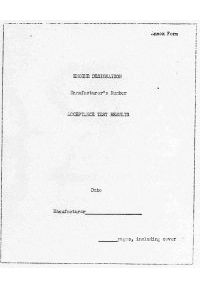 |
 |
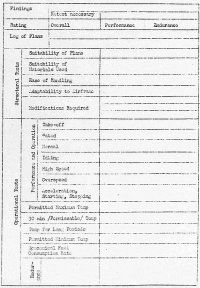 |
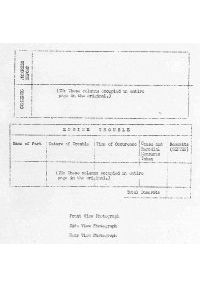 |
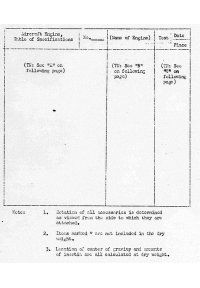 |
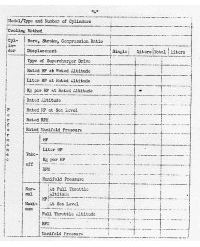 |
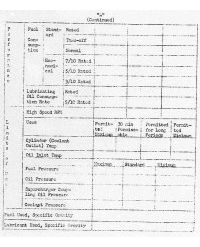 |
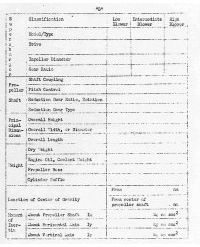 |
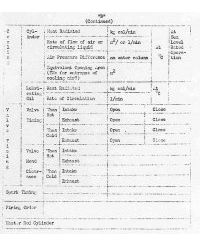 |
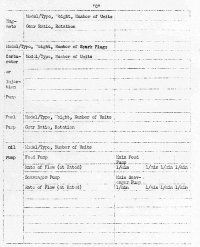 |
| |
|
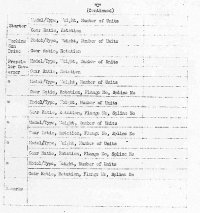 |
|
|
Precautions in Filling Out Table of Specifications
A. The following items are recorded in the column headed Carburetor or Injection Pump.
- 1. Carburetor
- a. Throat diameter, pressure drop, number of units.
- b. Standard adjustment and rate of flow at main jet.
- c. Standard adjustment and rate of flow at idling jet.
- d. Standard adjustment and rate of flow at economizer.
- e. Other necessary items.
- The term pressure drop at the throat refers to the difference between pressure in front of it and at the point of constriction at sea level rated operation and is expressed in millimeters of water.
- 2. Injection Pump
- a. Gear ratio; rotation.
- b. Number, diameter, and stroke of pistons.
- c. Standard adjustments.
- (1) XX-mm effective stroke a XX-mm manifold pressure
- (2) XX-l/hr flow capacity at XX RPM
- d. Injection valve: type and number.
- e. Injection tube: bore, outer diameter.
B. In the blank lines following the column for lubricating oil pump, the coolant pump, fan, and other such special accessories are to be recorded.
C. Various accessories are to be recorded in the blank columns following the columns for the propeller governor.
| Representative Graphs |
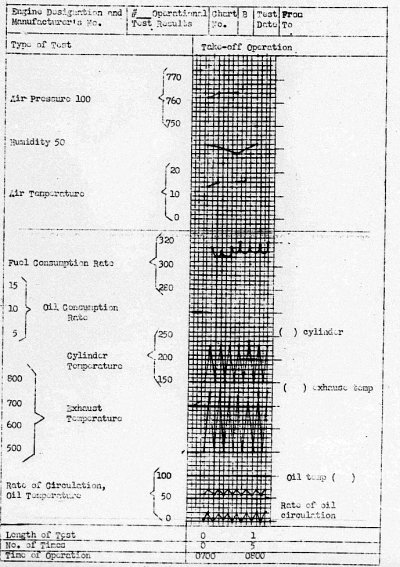 |
 |























